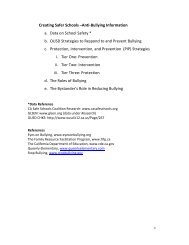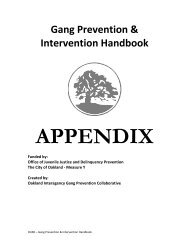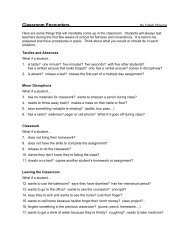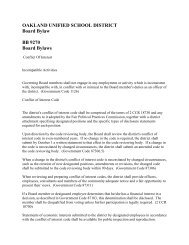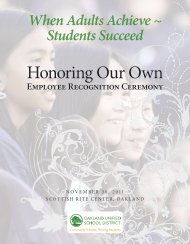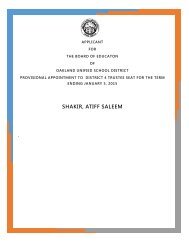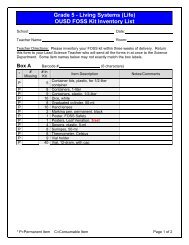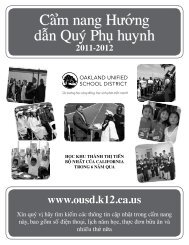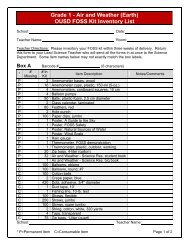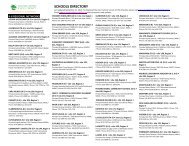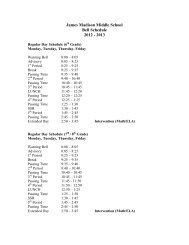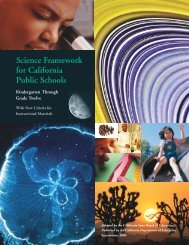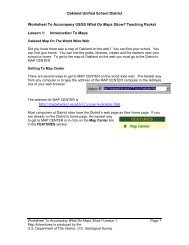Oakland Unified School District Case Study
Oakland Unified School District Case Study
Oakland Unified School District Case Study
Create successful ePaper yourself
Turn your PDF publications into a flip-book with our unique Google optimized e-Paper software.
Instructional Program<br />
During its 8 years of operation, AWE<br />
has experienced much variation in its<br />
instructional program and the curricular<br />
autonomy it is been given by the district,<br />
particularly in the area of English language<br />
arts (English language reading, writing,<br />
and speaking). The school has moved from<br />
an instructional program in which teachers<br />
exercised significant informal curricular<br />
autonomy, to strict adherence to the Open<br />
Court curriculum, to the current program<br />
based on adapting the Open Court curriculum<br />
to facilitate active learning opportunities<br />
and student mastery of key learning<br />
standards.<br />
Teaching methods varied greatly in AWE’s<br />
first 2 years. Teachers fought for and exercised<br />
curricular autonomy with little agreement<br />
on best practices. One district leader<br />
described the instructional program this<br />
way: “Although the school was supposed to<br />
be implementing the Open Court curriculum,<br />
they really just did their own thing.”<br />
After two years of API scores below 400<br />
(out of a possible 1,000), the district took a<br />
stronger role in AWE’s curriculum by holding<br />
them more accountable for implementing<br />
the Open Court curriculum. The district<br />
provided a coach to provide support and<br />
ensure compliance with the Open Court<br />
curriculum, and after two unsuccessful<br />
years focusing on social justice and a project-based<br />
curriculum that looked different<br />
in every classroom, the school finally began<br />
to focus on successful implementation of<br />
Open Court. After demonstrating to district<br />
officials that they could successfully<br />
implement the Open Court curriculum,<br />
the teachers began to develop methods<br />
for expanding Open Court in response to<br />
somewhat flat test scores in ELA. As Kean<br />
put it, “After showing the district we could<br />
do Open Court, we explained how we were<br />
interested in expanding it. We did what we<br />
were asked to, did it well, and then they let<br />
us breathe.” In spite of some teacher resistance<br />
to AWE’s shift toward the prescribed<br />
Open Court curriculum, many now acknowledge<br />
that it was a necessary intervention<br />
for developing instructional coherence<br />
and consistency at the school site.<br />
Today teachers at AWE use Open Court,<br />
but they have made adjustments in how<br />
it is used. Teachers deemed it necessary<br />
to supplement Open Court to better accommodate<br />
the needs of the diverse learners<br />
at the school. Literacy coach, Vanessa<br />
Flynn described the reasons and process for<br />
supplementing Open Court:<br />
We flattened out in our reading<br />
scores, it’s like 20% of kids were<br />
proficient. We weren’t seeing a lot<br />
of growth; it was pretty dismal. We<br />
needed to rethink things instructionally.<br />
When you walk into a classroom,<br />
it is the teacher who is doing<br />
the reading, who is doing the thinking,<br />
not the student.<br />
Teachers have to work so hard to<br />
make meaning of the text for the<br />
student. So that translates to when<br />
you sit a kid in front of test once a<br />
year, and it’s the first time all year<br />
they’ve actually read on their own<br />
and been asked to make meaning of<br />
text — they aren’t going to do well.<br />
To ensure that students are making<br />
meaning of text, we have to release<br />
that responsibility to them. I created<br />
a schedule that allowed for using<br />
Open Court as the base, and would<br />
fold in instruction to meet the students<br />
where they are.<br />
10<br />
<strong>School</strong> Redesign Network at Stanford University



